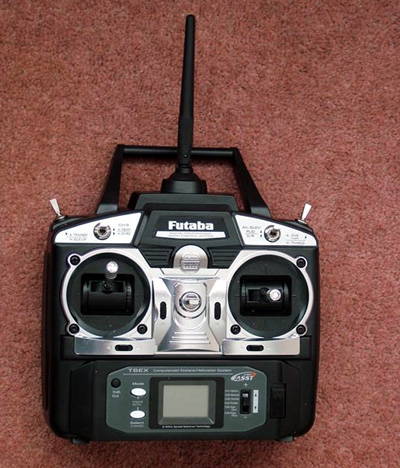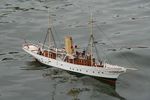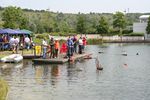Hot on the heels of the three channel Futaba 3 GR – FS 40 MHz Synthesised Transmitter and its R303FHS receiver comes the T6EX – 2.4 GHz Transmitter and R606FS receiver offering six channels and new technology. Based on the ‘new’ 2.4GHz band, the transmitter/receiver operate using the Futaba Advanced Spectrum Spread Technology (FASST). From what I have managed to research from the internet, all 2.4GHz systems have some eighty (80) channels available to them and may be used for air and ground-based models. The Futaba system uses each of the eighty channels for a fraction of time, before passing on to the next. If a channel is in use the speed of switching is so fast, (2 milliseconds) it makes no discernable difference in operation, either of the Futaba system or the system ‘occupying’ the channel. From information gleaned from the World Wide Web (www), it would appear that Futaba have been developing this technology for some fifteen years in their industrial r/c division. So what do you get for your money?As well as the six channel transmitter and corresponding receiver, there are four S3003 standard servos, a 700mA transmitter nicad (already fitted), a 700mA 4.8v nicad for the receiver, a switch charge/harness, a charger for both transmitter and receiver, a set of servo horns and a servo mounting tray, which is more suited to aircraft. The TransmitterThis is conventional in appearance, the only noticeable difference being the short stubby aerial, which may be folded down when not required for transport purposes – it is not telescopic. The aerial also pivots, allowing it to be positioned so that it is upright when in use. The instructions say ‘Never touch the aerial when in use’, as this can degrade the signal. A slider on-off switch on the front right hand corner of the transmitter, switches the power off and on. When on, the LED display shows the model type, the current model memory name and the transmitter voltage. The model type is selectable between aircraft and helicopter - I left mine on the aircraft setting, as both are irrelevant for model boats! The model memory stores settings for six models. This means all settings for a particular model can be instantly recalled. By using the model/select controls on the front panel, a four letter word, e.g. ‘Boat’, can be entered to identify each of the six models. These push button controls also allow for each servo to be reversed, dual rate settings to be adjusted (this is enabled by a switch on the top right of the transmitter) exponential settings to be set (giving proportionately greater or less movement of the servo at a given position of the transmitter stick) and the servo end point adjustment. This helps in situations where the standard servo throw is too little or too much. The operating controls are normal stick type, adjustable for length, operating in the usual manner, left and right, up and down, taking care of four of the available functions. These have the usual trim adjustment controls adjacent to them, which are now digital, giving more precise adjustment. The other two functions are enabled by conventional rocker switches. The left hand stick has a ratchet fitted in the up and down movement plane. This may be removed and replaced with a spring and adapter which are available from Ripmax. There is a charging jack on one side of the transmitter. When switching on, a LED on the rear of the transmitter (yes - the back of the tx) flashes red/green for a second or so, then stabilises on green to show the RF signal is active. When the receiver is switched on, this undergoes a similar process, showing red for about one second, and then switching to green. The instructions quote a ‘Link Procedure’ if another receiver is to be used with the transmitter. This entails pressing a recessed button on the new receiver for a couple of seconds, and the receiver LED will change to green when it has ‘found’ the transmitter. |
|
The ReceiverThis is quite compact (measuring 1.64 x 1.08 x 0. 36ins or 41.6 x 27.5 x 9.2mm) with the servo connections and switch harness at one end. The aerials, yes there are two, emerge from the other end. These aerials should be positioned so that the angle between them is a 90º right angle and they should be kept as straight as possible. Care should be exercised to keep the aerials away from large metal objects and as usual away from drive motors, electronic speed controller etc. As with all radio systems, a range check should be carried out before use. This system has a ‘Power Down Mode’ to make this process easier. With the Mode Key held down and then the power switched on, the output (RF) power is reduced. The model’s functions should be operational from thirty to fifty paces away. After one minute, the power will return to the normal level. The system has a couple of other functions. It has a trainer setting, primarily for aircraft modellers and a throttle-cut function which may be useful for i.c. boat modellers. The servos are exactly the same as the normal ones currently in use – if you want miniature or larger ones then just as with normal 27 and 40MHz equipment they can be purchased separately. When first available these systems were about £200+, but market forces are playing their part and the price has been driven down and a bit of searching will find these systems on offer around the £150 mark. I purchased mine from Inwood Model Supplies, tel: 01480 411519 (there is also a web site – www.inwoodmodels.co.uk)) for £134.99 plus £6.00 delivery. I also purchased the optional spring and plate for the left hand stick to replace the ratchet for £1.99. All I need now is a new model in which to install it permanently! |
Want the latest issue of Model Boats? Use our magazine locator link to find your nearest stockist!
 Make sure you never miss out on the latest news, product reviews and competitions with our free RSS feed
Make sure you never miss out on the latest news, product reviews and competitions with our free RSS feed

We welcome well written contributions from Website members on almost any aspect of Model Boating with a particular emphasis on practical hints, tips, experience and builds.
In order to maintain a consistent standard and format, all suggestions should first be sent to me by Personal Message for approval in principle. Only a very limited amount of time is available for editing contributions into a suitable format for placing on the website so it is important that the material is well presented, lucid and free from obvious spelling errors. I think it goes without saying that contributions should be illustrated by appropriate photos. I shall be happy to give advice on this.
The Member Contribution area offers space for short informative mini articles which would not normally find a place in Model Boats magazine. It is an opportunity for Website Members to freely share their expertise and experience but I am afraid that virtue is its own reward as there is no budget to offer more material recompense!
I look forward to receiving your suggestions.
Colin Bishop - Website Editor
Model Boats Magazine
- Landing Craft Mini PLan
- Riva Aquarama Build
- Scale Colour, Sound & Speed
Digital Editions
- Access your digital editions
Subscribe Now
- Every issue delivered right to your door
Renew Now
- Save & never miss an issue!

















 Register
Register Log-in
Log-in



